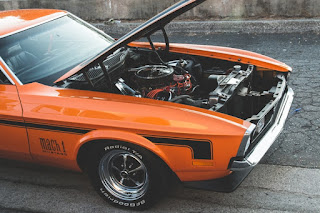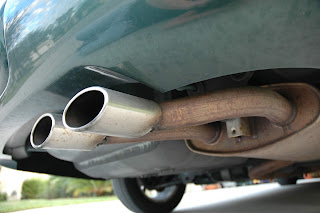The
prerequisites to rational decision-making are information and
knowledge. This is the reason why elderly people are considered
'wise'; we assume they must be having mountains of information and
knowledge given the experience they have. However, what if I tell
you, just information and knowledge are not enough? What is more
important is 'context'.
Once
you put the information and knowledge in the right context, then only
can you make the right decisions. This blog is all about how your car
works, so you can put this information in the context of maintaining
it. Also, maintaining your car properly will not only enhance its
performance but your experience too.
A
car, in the simplest terms, is an energy-conversion machine. It
converts the energy from the input (fuel) into a force that moves the
wheels. A car consists of many essential components and systems that
coordinate together to form a modern-privatised transportation
machine.
Major
systems of a car:
-
Engine and transmission
-
Braking
-
Suspension
-
Exhaust
For
now, let's have a look at the Engine and Braking system.
When
you open the hood of your car and view the engine, what you will see
is a big jumble of metal, tubes, and wires. It is quite confusing.
Let's see how it works.
The
engine is the heart of your car. It does the primary function of
converting heat energy into kinetic energy. In simpler words, the
engine converts fuel into motion. This is done by burning the fuel
inside the engine, hence the name 'internal combustion engine',
signifying that the combustion takes place inside the engine. There
are two important things to note here:
-
There are various types of engines which have their own advantages and disadvantages. For example, diesel engines, gas turbine engines, and HEMI engines.
-
There is such a thing known as an 'external combustion engine'. The most relatable example is the steam engine.
How
does internal combustion function?
The
engine consists of combustion chambers, piston, crankshaft, intake
valve, exhaust valve, and spark plug. The intake valve flows fuel and
air into the combustion chamber, and
the spark plug ignites it
causing thousands of controlled explosions; the fuel expands due to
the explosions and causes the piston to move. The piston is connected
to a crankshaft. The crankshaft starts rotating due to motion. Hence,
the engine converts heat energy into kinetic energy, or to be
precise, fuel into motion. This is the motion the wheel requires
to move. The transmission system moves the rotation power in the
engine to the wheels. This is done through the clutch and the
gearbox.
Now
that we know how an engine functions, let's try to understand the
possible problems you can face with it.
The
big three problems
As
said earlier, an engine is a big jumble of metal, wires, and tubes.
Even minor maladjustment can create problems. However, there are
usually three categories of problems that the engine faces- bad fuel
mix, lack of compression, and lack of spark.
Bad
fuel mix: This means the
problem is related to fuel. There are a number of possibilities like:
-
Your car is out of fuel
-
Clogged air intake
-
Fuel system supplying too much or too little fuel
-
Impurity in the fuel
Lack
of compression: When the
explosions occur inside the chamber, it is necessary for the engine
to compress those in order to move the piston. If the charge of air
and fuel lacks compression, the combustion process will not be
successful. Lack of compression can occur due to the following
reasons.
-
Worn out piston rings
-
Intake or exhaust valves are not sealing properly
-
Hole in the cylinder
Lack
of compression can be caused due to a 'leak' in the engine system.
Lack
of spark: The following are the
possible reasons for a lack of spark.
-
Worn out spark plug or wire
-
Discrepancy in ignition timing
-
Dead battery
There
are other factors to keep in mind too. For example, how engine timing
works, the cooling system, ancillary parts, and how or when the
intake and exhaust valves are opening and closing.
The
braking system can be considered the most vital in a car because it
ensures your safety. However, how it functions is quite fascinating.
Have you ever wondered how does a minute force on the brake pedal
stop a car that is moving at a fast speed? The answer, again, is in
energy conversion and multiplication. The braking system, like every
other system in a car, uses basic principles of physics- hydraulics,
and friction. There are different units in a braking system that work
in coordination to multiply the force from you apply on a brake
pedal. They are the following-
-
Energy-supplying device
-
Control device
-
Transmission device
-
The brake
Energy-supplying
device: This device supplies
and adjusts the energy required for braking. It uses force from the
driver (when s/he pushes the brake pedal) and kinetic energy from the
engine together. The braking force is assisted by atmospheric
pressure, vacuum, or hydraulic pressure.
Control
device: The brake pedal
Transmission
device: This usually refers to
the hydraulic system. A transmission device converts and multiplies
the force being used.
Brake:
A brake is a mechanical unit in
itself. In simple words, the brakes use friction to stop the wheels.
Let's try to understand the brakes in detail. It consists of a
piston, callipers,
brake pads, rotor, and hub. The piston is attached to the hydraulic
system. So as we push the brake pedal, it causes the piston to move.
This motion, in turn, makes brake pads (attached to callipers)
to tightly stick with the rotor (which is connected to the wheel
through a hub). The friction is the force that stops the motion of
the wheels.
How
to maintain the braking system?
Unless
someone wants to risk an accident, it is wise to check and maintain
the braking system regularly. Let's see how it can be done.
Brake
callipers, pads, and rotors: The
efficiency of the braking system mainly depends on how well the
callipers,
pads, and rotors work together. It is necessary to get them checked
regularly considering the wear on the pads. Even though it depends on
the usage of the car, one should know the average life of these
parts.
Brake
fluid: Good quality brake fluid
is required for the hydraulic system (transmission) to work
correctly.
Check the brake fluid regularly and get it changed approximately
every two years.
A
leak in the hydraulic system: If
there's a leak in the hydraulic system, there'll be a lack of
compression, and hence, the piston won't move properly. Hence, get
the hydraulic system checked if your brakes are not working properly.
Suspension
The
suspension system is to provide safe handling and maximum traction
while being able to sustain passenger comfort. This is the basic
requirement expected out of a suspension system. To accomplish this,
it uses various tools. For example, springs, shock absorbers, control
arms, etc. All the components must work together to enhance the ride
quality and handling characteristics that are expected by the driver
and passengers.
Functions
of the suspension system
-
Reducing bump and shock
-
Good handling and control
-
Comfort of the driver and passengers
How
does this happen? The tyres must be able to rise and fall relative to
the body, in order to allow the springs and shocks to reduce the bump
and road shock. Springs and shocks are installed to absorb energy
that is created by a bump. They ensure a smooth ride while not
allowing the uncontrolled movement of the tyres.
The
suspension system also handles the movements caused due to
acceleration, braking, and cornering. The springs also ensure an
adequate height of the vehicle. Also, a crucial area concerning the
suspension system is the alignment of the wheels. Any minor
maladjustment in the suspension system can cause wear or damage to
other parts of the car. We can say that the suspension system ensures
balance and maintains the proper functioning of the car as a whole.
If you face problems with handling and control, or you feel that your vehicle is not able to absorb shocks, it's wise to visit your nearest garage. Carelessness with the suspension system can cost to a pretty penny.
If you face problems with handling and control, or you feel that your vehicle is not able to absorb shocks, it's wise to visit your nearest garage. Carelessness with the suspension system can cost to a pretty penny.
The
exhaust system has a relatively simple function, but it is vital for
preventive measures and safety. There are a lot of harmful gases that
are released due to the reactions in the engine. These gases need to
let out of the vehicle safely . This is what the exhaust system does.
It consists of an exhaust manifold, heat riser, exhaust pipe,
catalytic converter, muffler, and tailpipe.
Exhaust
manifold: It collects the
residue from the engine cylinders to direct them to the exhaust pipe.
Heat
riser: It is a valve that
transfers a small amount of exhaust gases to the heat stove. The heat
stove provides help in vaporising the air/fuel mixture making through
the intake manifold.
Exhaust
pipe: The function of the
exhaust pipe is to safely transfer the exhaust gases from the exhaust
manifold to the catalytic converter, and also, reducing noise.
Catalytic
converter: This component is
important for emission
control. The catalytic converter converts harmful carbon monoxide and
hydrocarbons into carbon dioxide and water vapour. Some converters
also change nitrogen oxides into oxygen and nitrogen. By law, the
catalytic converter must be installed on a vehicle.
Muffler:
It reduces noise by letting the
exhaust gases expand. The expansion flows and cools the exhaust gas
flow. This reduces noise without obstructing the flow of gases.
If
you hear unusual sporty noise while starting your vehicle, there's
probably a leak in the exhaust system. Leaks can be dangerous, and it
is wise to ask your mechanic to thoroughly check the exhaust system
whenever you send your car for maintenance.
If
you require Car Service Northampton, you can visit us at
Jackson's MOT Centre.



